On a sweltering late July morning, everyone’s tempers were short – those of the people and the roughly 80,000-plus honey bees in the hives maintained by the staff at Adath Jeshurun Congregation.
The July heat that hammered the Twin Cities meant that the crowded hives the synagogue oversees and produces honey from were also hot. The plan this morning was to drill an extra hole in one of the hive boxes for extra ventilation.
People paced around the small, fenced-in enclosure where the hives are, discussing strategies and opening up the boxes to check the status of honey production.
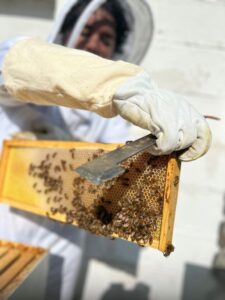
Armando Vazquez Torres inspects a frame at the Adath Jeshurun Congregation beehive. (Photo by Lonny Goldsmith/TC Jewfolk).
“If you’re really only going to drill one hole, I would do that last,” said Jenifer Robins, who until recently was Adath’s director of young adult and family life, to Adath’s Lea Brand and Armando Vazquez Torres. Robins has been a beekeeper for the last three years and is helping mentor Brand and Vazquez Torres who supervise the bees at the synagogue. “Because you know what’s going to happen? They’re not going to be happy we have to drill. I have the same problem at my house. I think it’s getting so hot. We should give them as much ventilation as possible.”
Robins is one of a group of beekeeping hobbyists in the Twin Cities, whose season is starting to wind down as fall approaches and they start to extract the honey in time to either enter in last month’s Minnesota State Fair or more pertinent, for Rosh Hashanah. Some are Jewish, some are not, but all have found a connection to each other through nature – and the camaraderie that comes from taking the hobby on and having each other to lean on when things get difficult.
Like when figuring out how to best drill holes in a hive box with tens of thousands of bees.
The Adath experience has been an interesting one for Brand, a preschool teacher at Adath’s Gan Shelanu, and Vazquez Torres, who along with his father Mauricio Vazquez, are part of Adath’s facilities team. Vazquez Torres got the hives started this season in mid-April, without the help of Robins, who was in Israel at the time.
“My dad sent me a link to videos of how to install the bees,” said Vazquez Torres. “I looked at it at least five times.”
While the first year of their partnership wasn’t successful – the hives haven’t produced honey – Brand is looking forward to next year already.
“I think we’ll do better next year,” she said. “They threw Armando and I into this without any help, knowledge, or education, so we’ve been leaning really hard on Jen. Jen is here helping us out of the goodness of her heart.”
Teaching others
Mentoring beekeepers is something that Robins enjoys, which is something that she learned from her own mentor, Barry Ross.
“I keep doing this because I find new mentees,” said Ross. He got involved when two of the riders he cycled with took up beekeeping. Eventually, one moved away and the other decided to get out of the hobby, and Ross inherited all of their equipment.
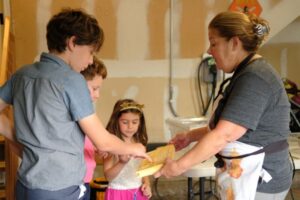
Heschel Fisher, Joey Fink and Maytal Ribnick taste honey right from the frame Jenifer Robins holds before it is extracted. (Photo by Lev Gringauz/TC Jewfolk).
“I said, ‘Well, I might as well give it a shot,’” Ross said. “I went and took some classes at the University of Minnesota.”
Ross’s classes at the University of Minnesota didn’t help his prospects the first year.
“It was a total disaster. And I said I’m not doing this anymore. I quit,” he said. “Something got me to do a second year and the rest is history. I’ve been beekeeping for 10 years now.”
Shortly before Ross got into the hobby, the U started its Bee Squad program, which is the education and outreach arm of the Bee Lab at the University of Minnesota.
“There was a big uptick in beekeeping interests in the window of time when we started the Bee Squad, and we were like, we have to do more outreach and we need to have more training,” said Jessica Helgen, the Bee Squad’s education program associate. “I think it’s not necessarily that we’ve had more and more people every year [start beekeeping], but I think the conversation about what it means to help bees and help pollinators has really changed.”
Helgen said that bees are a non-native species, so the average urban yard or urban ecosystem has no need for honeybees.
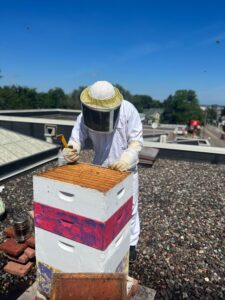
Jonathan Kvasnik checks the frames in his hive which sits on the roof of his St. Paul office. (Photo by Lonny Goldsmith/TC Jewfolk).
“The thing that we’ve noticed is that people are kind of asking us about what can I do to help the bees, instead of asking how can I manage a honeybee colony?” she said. But if beekeeping is for you, Helgen said there’s strong support for that in the Twin Cities. “We have some really active beekeeping clubs, and I feel like there’s a lot of strong support for it in the Twin Cities. We have ordinances in both Minneapolis and St. Paul, and a lot of the surrounding cities that are pretty supportive of beekeeping.”
Jonathan Kvasnik’s office at the Bank Cherokee building in St. Paul has the evidence of city ordinances at work. He displays the eight years of city licenses – one for each year of his beekeeping work – in the office on Smith Avenue, just east of the high bridge. The licenses are displayed there because one of his five colonies is housed on the roof of the building.
“I took the class at the U, bought all of the stuff, and my dad was adamant: You’re not putting that in your yard next,” said Kvasnik, whose parents live next door to him and his wife in St. Paul. His father is allergic to bees. “That’s how I ended up here.”
Kvasnik also has colonies in Minneapolis near Lake Nokomis, and in Grant Township, which is between White Bear Lake and
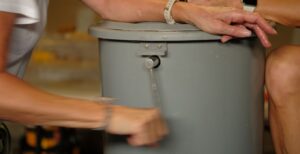
Sara Richter spins the extractor while Kari Clark stabilizes the centrifuge to spin the honey out of the frames. (Photo by Lev Gringauz/TC Jewfolk).
Stillwater, northeast of St. Paul. The different locations – and different years – mean the honey that is produced can have a different flavor profile each year.
“Every season is a little different,” he said. “Last year the honey was very dark and it had a very rich flavor.”
Kvasnik said that the St. Paul batch was mainly foraged along the Mississippi River, which is less than a mile from the hive. The Minneapolis hive is near a lot of wildflowers and gardens in the Nokomis area, and Grant has a lot of marshlands.
“The variety of what’s available is what determines the flavor and it’s definitely distinctively different,” he said. “The color won’t be the same, the taste won’t be the same. It’ll be close because I’m not putting them in a field. It’s all very much an urban setting.”
Liquid gold
On a recent Saturday afternoon, families who live in Robins’s neighborhood were walking back from services at Beth El and took her up on an offer to see the bees. Four of the kids got into child-sized bee suits to get close to the hives.
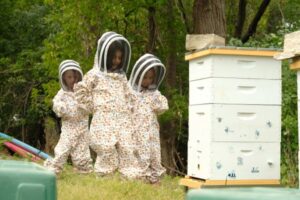
From left: Dena Fink, Maytal Ribnick and Thea Fink wear protective bee suits to get close to the hives in Jenifer Robins’s backyard. (Photo by Lev Gringauz/TC Jewfolk)
“I had [the smaller suits] at Adath, and I think it’s so fun,” Robins said. “Today was just show – they wanted to put the thing on. But if they come back and go into the hive, you will see the spark. Like when Sara first went in the hive.”
Sara Richter is a longtime friend and former roommate of Robins. She splits her summer between the Twin Cities and Madeline Island, Wis., and has a colony of bees there.
“Jen and I both ended up back moving back home which is Minneapolis and fast forward – I don’t even want to tell you how many years – and she wanted to show me the hive so I went in her hives last year,” she said. “And I was like, oh, I want to do this.”
Unfortunately, her first season won’t have any honey to show for her work; she showed pictures on her phone of the aftermath of a bear knocking over her hive. The hive is still intact, but is now marked up with bear paw prints and scratches, she said.
In Ross’s yard, he has his two hives, and two of Kari Clark’s, who along with Richter and Robins, started the honey extraction process on a recent Saturday afternoon in Robins’s garage.
The extraction process can be an exhausting one. Clark has 13 full frames of honey, capped by a layer of beeswax. Robins plugs in a knife to a nearby outlet and the three take turns slowly scraping the wax off the honey. Two frames at a time are then put into a spinner, and then a handle is cranked, spinning the frames at speed for about a minute. The trio checks the frames, and when satisfied that all the honey is out of one side, they turn the frames to extract from the other.
When it’s full, they open a tap at the bottom of the extractor and watch as the honey flows into a bucket covered by a filter. Robins said she’ll change the filter several times, and clean the old ones as a build-up of wax prevents the honey from flowing through. The bucket also has a tap on it, which can be opened to fill the jars of honey.
“I made four-ounce jars last year, and this year I’m going to up to six,” said Clark, who gives away the honey each year. “I love the idea of it being part of a holiday like Rosh Hashanah, but I give it out at New Year’s or Christmas…I gave it out to clients for an end-of-the-year gift.”
Most of the hobbyists give their honey as gifts, including Robins’s You Betcha, Honey! Kvasnik’s Honey Money is sold at Cecil’s Deli in St. Paul – which is owned by his wife’s family – and he gives all the money made from it back to environmental education causes.
Jewish connections
Ross gives his beekeeping knowledge away as freely as he does the honey he extracts from his colonies each year. But he admits he – and most beekeepers – have a long way to go in learning all there is to know.
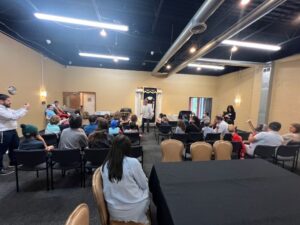
Barry Ross teaches about beekeeping to a group of students and families at Minneapolis Chabad Sunday School. (Photo by Lonny Goldsmith/TC Jewfolk)
“We know a lot less than we don’t know,” he said to a group of Sunday school students at Chabad in Minnetonka. He said he loves speaking to groups of kids about the practice of beekeeping and producing honey. He brought a bottle of a previous season’s honey for the students and their families to try.
“Honey is mentioned 22 times in the Torah,” Ross told the group. “We have a long, long connection with honey.”
Most honey is kosher. Ross tells the students that he filters his honey after removing it from the frames in the beehives so that there are no bee parts in the final product; the presence of bee parts would render it unkosher.
So why is honey kosher if the bees that produce it are not kosher? Of course, the Talmud has answers.
Honey is created by the nectar the bees gather, and when combined with the enzymes in the bee, makes the honey. The nectar isn’t digested by the bee, which means that the honey is not a product of the bee, the way that milk is the product of a cow.
The tricky part comes from adding flavors or additives that may not be kosher.
“I’m kind of against the idea of infusing it with something because I don’t want to be responsible,” Kvasnik said.
The colony, in many ways, is like a kibbutz.
“Everybody thinks that the Queen is in charge, but she’s actually not in charge. It’s just like Hashem; the colony is in charge,” said Kvasnik. “The colony, they serve others by working together. No one can break away. No one can say, I am in charge, I have a better idea. They work together.
“They’re a perfect utopia: they have no independence of each other, and no one’s in charge. Just like the Jewish people. We all are one. No one should be in charge. And we all serve one God. They all serve one entity, and that’s the colony. If [something] tries to sneak into the colony, that bee is going to sacrifice herself to protect the Queen and the survival of the colony above all else. She’s not going to worry that she has to die for the benefit of the colony. She’s just going to do it because that’s what they’re designed to do. And that’s the relationship between us and the Jewish New Year.”

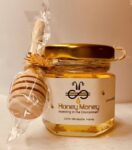
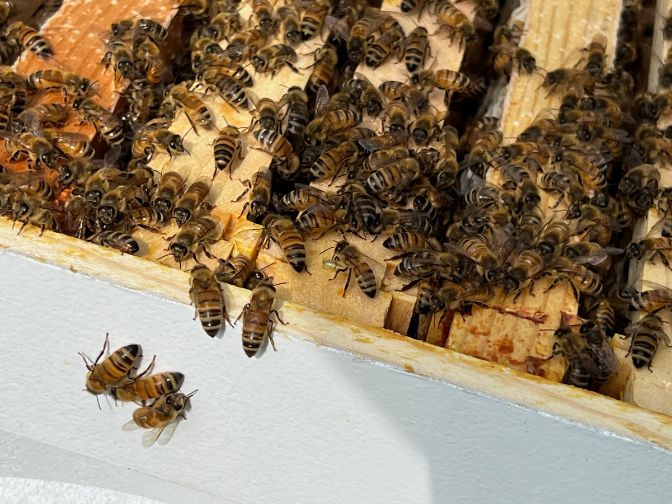

1 comment